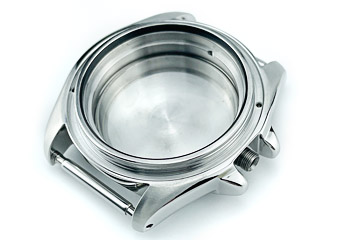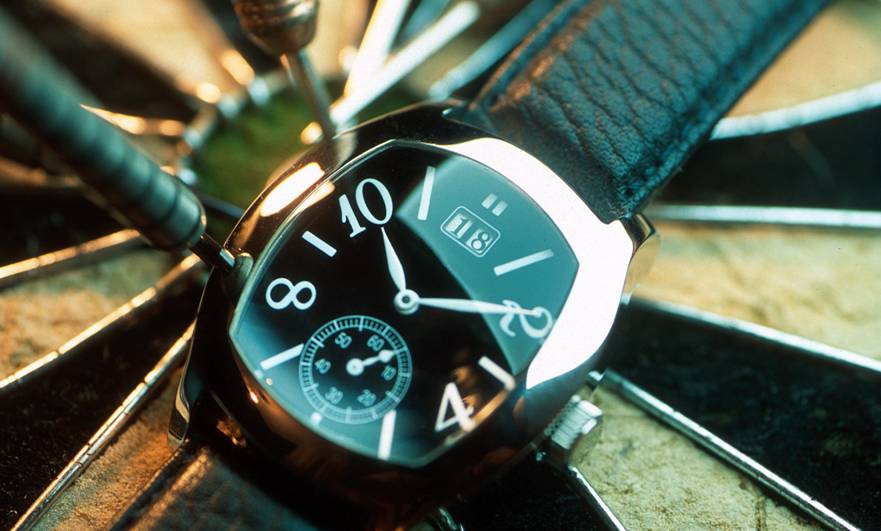15 years one-stop China custom CNC machining parts factory

Hey there I’m VMT Sam!
With 25 years of CNC machining experience we are committed to helping clients overcome 10000 complex part-processing challenges all to contribute to a better life through intelligent manufacturing. Contact us now
 252 |
Published by VMT at Sep 06 2023
252 |
Published by VMT at Sep 06 2023
Polishing Challenges in CNC Machining Stainless Steel Watch Case
Stainless Steel Watch Case CNC Machining
Many renowned watch cases are crafted from 316L stainless steel, known for its durability and elegance. To enhance their luster, these cases undergo polishing. After the polishing process, they exhibit a dazzling metallic sheen, attracting consumers' attention. Some may combine matte or sandblasted surfaces with high-gloss areas to enhance the watch's overall texture. A striking surface and smooth lines showcase the results of the polishing process, but maintaining edges and lines is essential to reveal its beauty.
The general process of manufacturing a watch case includes stamping and cutting, CNC milling to shape the case blank, precision machining, opening for the watch face, chamfering with asbestos wheel, beveling with grass wheel, polishing, sandblasting, cleaning, drying, and finally, assembly.

The polishing of the watch case is mainly done by hand. It usually starts with sisal wheels and purple wax to remove sanding marks, followed by cloth wheels and green or white wax to eliminate sisal and purple wax patterns. This stage achieves an initial level of gloss, and then fine cloth wheels with small green or white wax are used for final polishing to achieve a mirror-like finish.
Matte finishing techniques include straight-line sanding and bead blasting with glass beads. The combination of high-gloss and matte surfaces involves first completing the polishing and then protecting the glossy areas with special materials. These areas are then sandblasted or brushed to create a textured matte surface, adding depth and appeal to the visual effect.
Stainless Steel Watch Straps and Bracelets Crafting
The production of watch straps and bracelets involves various requirements, including brushing, matte, gloss, and high-gloss finishes. To save costs, some manufacturers use 304 stainless steel particles for brushing and matte finishes. The general process for crafting watch straps includes stamping and cutting, vibratory grinding and polishing, wire cutting, drilling, disc sanding, polishing, sandblasting, cleaning, drying, and pin insertion.
Matte finishing for watch straps is relatively simpler compared to watch cases. This is because watch straps are often composed of stainless steel particles that undergo CNC machining and recombination. The polishing process is essentially the same.
It's important to note that when polishing stainless steel or precious metals, minimizing material loss is crucial. Stainless steel watch cases and straps, after deep polishing, should have a deep mirror-like finish with no visible scratches or polishing marks. German company Menzerna, with 134 years of experience, sets the highest standard in achieving this level of quality. Polishing compounds emphasize specific gold and silver luster, aid in heat dissipation, and reduce grinding wear.
Tools Used for Stainless Steel Watch Case Polishing
Polishing requires various tools, including sisal wheels, cloth wheels, nylon wheels, abrasive bars, polishing machines, oil stones, UB grass wheels, FBB fiber wheels, PVA titanium hollow fiber wheels, titanium hollow wire wheels, and polishing waxes of different grades. Let's analyze some key polishing tools:

Sisal Wheels: These are typically made from woven sisal fabric and are used for rough grinding and removing sanding marks.
Cloth Wheels: Made from different fabrics like twill, satin, and plain, these are used for intermediate polishing to achieve a glossy surface.
Mirror Polishing Cotton and Flannel Wheels: These soft wheels, often used with blue or orange polishing compounds, are essential for the final mirror-like finish.
Ultrasonic Cleaning: After polishing, the watch case undergoes ultrasonic cleaning to remove any remaining residues and contaminants.
Inspection: Each CNC-machined watch case undergoes a thorough inspection to check for any remaining defects or imperfections.
Final Quality Control: The last step involves final quality control checks to ensure that the CNC-machined watch case meets the desired surface smoothness, dimensions, and overall quality specifications.
It's worth noting that the specific polishing techniques and compounds used may vary based on the manufacturer's preferences and the desired surface smoothness for the watch case.
Stainless Steel Watch Case Mirror Polishing Surface Treatment Process
Mirror polishing aims to create a surface that is as reflective as a mirror, with no visible imperfections or lines, even under magnification. Here's an overview of the steps in achieving mirror polishing for stainless steel CNC watch cases:

Surface Preparation: Before polishing, the CNC watch case's surface is thoroughly cleaned to remove any contaminants, oil, or residues.
Polishing Steps: The polishing process typically includes grinding, rough polishing, intermediate polishing, fine polishing, ultra-fine polishing, final polishing, manual polishing, ultrasonic cleaning, inspection, and final quality control.
Grinding: The initial step often involves using abrasive belts, flap wheels, nylon wheels, or grinding wheels to remove any sharp edges, sanding marks, stretching lines, or orange peel texture from the surface.
Rough Polishing: Sisal wheels with purple wax are commonly used to remove sanding marks and any remaining surface imperfections. This stage creates a smoother surface with some initial gloss.
Intermediate Polishing: Cloth wheels with green or white wax are used to further enhance the gloss and remove any remaining sisal wheel patterns or purple wax marks.
Fine Polishing: Fine cloth wheels with small green or white wax are employed for detailed polishing, achieving a mirror-like surface gloss.
Final Polishing: This step aims to achieve a mirror-like effect. Very fine abrasives and soft fabric or felt wheels are used. Multiple passes may be made to ensure a high-gloss, reflective surface.
Manual Polishing: For intricate details, edges, and hard-to-reach areas, skilled craftsmen may perform manual polishing. This meticulous process ensures that every part of the CNC watch case is polished to perfection.
Ultrasonic Cleaning: After polishing, the watch case undergoes ultrasonic cleaning to remove any remaining polishing compounds and contaminants. This step helps maintain the cleanliness of the watch case.
Inspection: Each CNC-machined watch case is thoroughly inspected to detect any remaining imperfections or defects. Any issues are addressed before proceeding.
Final Quality Control: The last quality control checks are conducted to ensure that the CNC-machined watch case meets the required surface smoothness, dimensions, and overall quality standards.

Please note that the specific polishing techniques and compounds used may vary depending on the manufacturer's preferences and the desired level of surface smoothness for the watch case.
Frequently Asked Questions (FAQs)
How long does it take to CNC machine and polish a stainless steel watch case?
The time required can vary based on factors such as complexity, material, and machining speed, ranging from several hours to several days.
Apart from stainless steel, what other materials are commonly used for watch cases?
In addition to stainless steel, popular materials for watch cases include titanium, various alloys, and even precious metals like gold.
What steps are taken to ensure a perfect fit between the watch movement and the watch case?
Achieving a perfect fit involves maintaining tight tolerances, precise measurements, and rigorous quality control checks throughout the process.
Is CNC machining the only method for crafting stainless steel watch cases?
While CNC machining is widely used, some manufacturers may opt for traditional handcrafting methods, especially for limited-edition timepieces.
How does CNC machining contribute to the customization of stainless steel watch cases?
CNC machining allows for intricate and personalized designs, making it essential for creating unique and bespoke stainless steel watch cases with specific surface finishes.
These FAQs provide valuable insights into the CNC machining and polishing processes for stainless steel watch cases and bracelets. If you have more questions or need further information, feel free to reach out to us.
Ready To Start Your Next Project?
Get Instant Quote

Request a Free Quote
Send us a message if you have any questions or request a quote. We will get back to you ASAP!